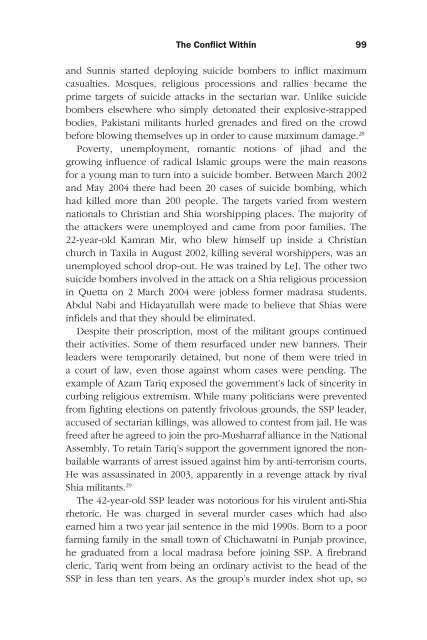Frontline Pakistan : The Struggle With Militant Islam - Arz-e-Pak
Frontline Pakistan : The Struggle With Militant Islam - Arz-e-Pak
Frontline Pakistan : The Struggle With Militant Islam - Arz-e-Pak
Create successful ePaper yourself
Turn your PDF publications into a flip-book with our unique Google optimized e-Paper software.
<strong>The</strong> Conflict <strong>With</strong>in<br />
and Sunnis started deploying suicide bombers to inflict maximum<br />
casualties. Mosques, religious processions and rallies became the<br />
prime targets of suicide attacks in the sectarian war. Unlike suicide<br />
bombers elsewhere who simply detonated their explosive-strapped<br />
bodies, <strong><strong>Pak</strong>istan</strong>i militants hurled grenades and fired on the crowd<br />
before blowing themselves up in order to cause maximum damage. 28<br />
Poverty, unemployment, romantic notions of jihad and the<br />
growing influence of radical <strong>Islam</strong>ic groups were the main reasons<br />
for a young man to turn into a suicide bomber. Between March 2002<br />
and May 2004 there had been 20 cases of suicide bombing, which<br />
had killed more than 200 people. <strong>The</strong> targets varied from western<br />
nationals to Christian and Shia worshipping places. <strong>The</strong> majority of<br />
the attackers were unemployed and came from poor families. <strong>The</strong><br />
22-year-old Kamran Mir, who blew himself up inside a Christian<br />
church in Taxila in August 2002, killing several worshippers, was an<br />
unemployed school drop-out. He was trained by LeJ. <strong>The</strong> other two<br />
suicide bombers involved in the attack on a Shia religious procession<br />
in Quetta on 2 March 2004 were jobless former madrasa students.<br />
Abdul Nabi and Hidayatullah were made to believe that Shias were<br />
infidels and that they should be eliminated.<br />
Despite their proscription, most of the militant groups continued<br />
their activities. Some of them resurfaced under new banners. <strong>The</strong>ir<br />
leaders were temporarily detained, but none of them were tried in<br />
a court of law, even those against whom cases were pending. <strong>The</strong><br />
example of Azam Tariq exposed the government’s lack of sincerity in<br />
curbing religious extremism. While many politicians were prevented<br />
from fighting elections on patently frivolous grounds, the SSP leader,<br />
accused of sectarian killings, was allowed to contest from jail. He was<br />
freed after he agreed to join the pro-Musharraf alliance in the National<br />
Assembly. To retain Tariq’s support the government ignored the nonbailable<br />
warrants of arrest issued against him by anti-terrorism courts.<br />
He was assassinated in 2003, apparently in a revenge attack by rival<br />
Shia militants. 29<br />
<strong>The</strong> 42-year-old SSP leader was notorious for his virulent anti-Shia<br />
rhetoric. He was charged in several murder cases which had also<br />
earned him a two year jail sentence in the mid 1990s. Born to a poor<br />
farming family in the small town of Chichawatni in Punjab province,<br />
he graduated from a local madrasa before joining SSP. A firebrand<br />
cleric, Tariq went from being an ordinary activist to the head of the<br />
SSP in less than ten years. As the group’s murder index shot up, so













